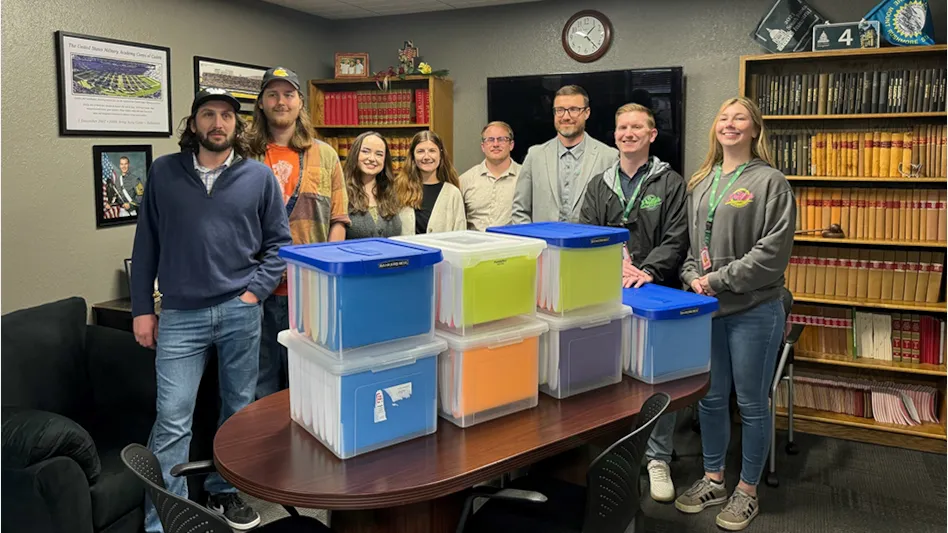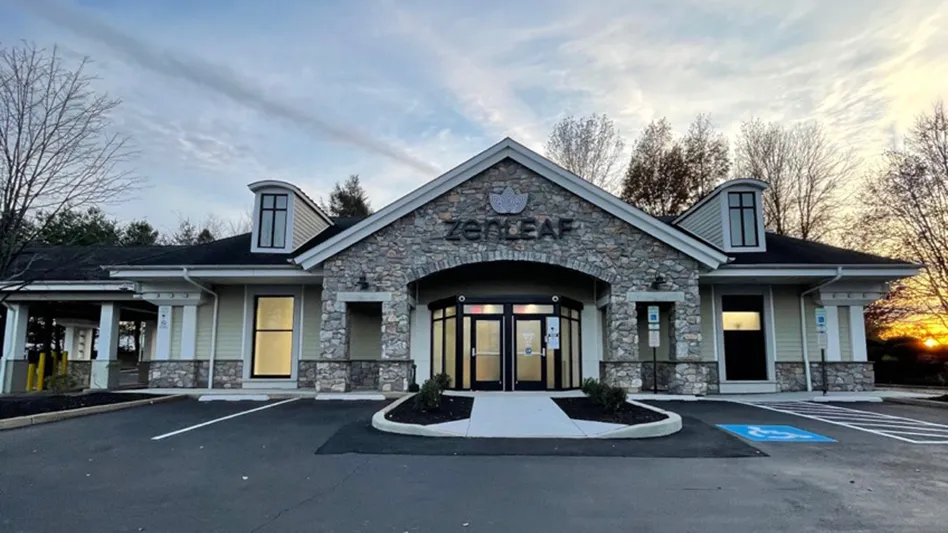
Adobe Stock
The taxman will soon be after hundreds of California’s licensed cannabis businesses.
As of Dec. 31, 2023, nearly 15% of the state’s cannabis operators—including retailers, distributors and other tax-obligated businesses—were in default of their sales-and-use tax obligations, totaling $189.3 million in default, according to the California Department of Tax and Fee Administration (CDTFA). The rate for this tax ranges from 7.25% to 10.75% depending on locality.
In addition, 15.4% of California’s retail licensees were in default of their cannabis excise tax, totaling more than $54.2 million in default, according to the CDTFA. The current rate for this tax is 15% statewide but is set to automatically increase to 19% in 2025 (more on this below).
The combined amount of $243.5 million in default is attributable to cannabis businesses that had licenses and were open at any point in time in 2023, with a large portion of what's due coming from penalties and interest on the unpaid taxes, according to the CDTFA. Specifically, California's Cannabis Tax Law imposes a mandatory 50% penalty for late or missed payments, which voters approved with the 2016 passage of Proposition 64.
This information on cannabis accounts receivable was shared with Cannabis Business Times via a California Public Records Act (PRA) request the CDTFA fulfilled for a client represented by Hirsh Jain, founder of industry consultancy Ananda Strategy, which represents many of California’s cannabis operators throughout the supply chain. CBT confirmed the data in the PRA with the CDTFA.
Jain also is on the Cal NORML Board of Directors and serves as the vice chair of the California Cannabis Chamber of Commerce.
“A lot of California cannabis retailers aren’t paying their bills, and in part they’re citing the fact that they’re behind on their taxes,” Jain told CBT. “This is kind of the talk of the town in the California cannabis industry. … This is widespread knowledge about what is happening in California cannabis, and now we have the actual data that shows how many people are in default.”
RELATED: California Cannabis Operators in Peril as American Dream Turns to Nightmare
California had roughly 1,240 active dispensary licenses and 500 active delivery licenses—those specifically liable for the state’s 15% cannabis excise tax levied at retail—during various points in 2023, according to the California Department of Cannabis Control (DCC). At a 15.4% default rate on the excise tax, this means roughly 250 retail businesses throughout the state under these two licensing categories are behind on either all or part of their tax obligations.
This 250 number is an estimate, as not all active licensees in 2023 were open and operational, while others that were open closed.
A Market-Wide Impact
The ramifications of industry players falling behind on their bills has created widespread ripple effects across the state marketplace, as many of these businesses in default also owe money to cannabis brands and other state-licensed cannabis operators.
“That’s the really scary thing, because imagine if you’re a dispensary that’s in hundreds of thousands of dollars of debt to the CDTFA and to a bunch of cannabis brands,” Jain said. “Who are you more scared of? These cannabis brands, or the United States government that can come after you with the force of the law?”
If a business cannot pay an entire tax amount due, the CDTFA recommends paying as much as one can to minimize the amount of interest and penalties that can accrue on unpaid taxes or fees. For companies that don’t pay their taxes in full, the CDTFA has collection and enforcement mechanisms in place, such as:
- placing a lien on property;
- seizing real or personal property;
- levying bank accounts, salaries or wages;
- issuing “till-tap” or “keeper” warrants to collect money from cash registers and proceeds of a business during the day; and
- suspending a company’s seller’s permit or revoking a license.
In addition, “Cannabis Tax Law, in certain situations, allows for an individual to be found personally liable for a business’s unpaid taxes owed to the state,” according to a CDTFA statement provided to CBT.
While the $243.5 million in default at the end of 2023 represents just 4% of the nearly $5.9 billion in tax revenue paid by California cannabis businesses since adult-use sales launched in January 2018, it's a make-or-break scenario for many operators in today's market. On average, 94% of total taxes reported on cannabis have been paid since 2018, according to the CDTFA.
When CBT reached out to the DCC to ask what the best course of action is for distressed operators unable to pay their taxes, the department deferred to the CDTFA, recommending that those in default reach out to the tax agency for potential solutions.
The CDTFA does offer weekly, biweekly and monthly payment plans through an online automatic withdrawal process, but these plans are more costly than paying the full amount owed and also may be more costly than borrowing funds to pay the amount owed, according to the CDTFA.
The Next Drug War?
The blunt reality, though, is that many cannabis operators who “poured a decade of their lives” into the California adult-use industry are on the verge of losing everything, Jain said.
“We are on the path to re-engaging in the war on drugs in California,” he said of CDTFA officials potentially going after individuals, including low-income or social equity operators, to personally hold them liable for the tax obligations of their businesses.
“They are ruthless in their efforts to collect taxes,” Jain said of the CDTFA. “What we might see is hundreds of legal California cannabis businesses being chased mercilessly by the government. And honestly, that’s not too different from the asset forfeiture practices that took place in California 20 years ago. So that’s the supreme irony of how it’s kind of like the war on drugs 2.0, but now just through a different agency: the CDTFA.”
Many of California’s distressed cannabis businesses with the biggest bills to pay are based in Los Angeles County, the most populated county in the U.S. with nearly 10 million residents. The county represents California’s most crowded marketplace with 384 active dispensary licenses (31% of the state) and 175 active delivery licenses (40% of the state), according to the DCC.
Although California has one of the lowest dispensary rates in the nation at 3.2 stores per 100,000 residents, many of the state’s retail facilities are clustered in certain regions as a result of the 60% of California cities and counties (324 of 539) that prohibit cannabis sales, according to the DCC.
Amid a competitive landscape, LA County is experiencing a dramatically different rate of distressed cannabis businesses than the rest of California, Jain said. The fact that cities in LA County levy some of the highest sales-and-use tax rates in the state only compounds this landscape.
“So not only is there a lot of competition, but the taxes are really, really high,” he said. “Another thing is that there’s an estimated 800 to a thousand illegal dispensaries in LA. And so, a lot of these operators open up, and they’re competing with five illegal shops within two blocks that don’t pay taxes.”
Editor’s note: While it’s unclear how many unlicensed dispensaries are in Southern California, a February analysis by the Pew Research Center found that LA County has 1,481 dispensaries. But only 384 dispensaries in the county have active licenses, according to the DCC’s data.
In turn, LA County-based cannabis businesses represent the majority of sales-and-use tax dollars in default in California with nearly 22% of operators owing more than $106 million in unpaid taxes at the end of 2023, according to the CDTFA. Furthermore, 15% of LA County retailers are in default for nearly $17 million in unpaid cannabis excise taxes.
| Account Type | Statewide Default | LA County Default | Statewide Amount | LA County Amount |
|---|---|---|---|---|
| Sales and Use Tax | 14.86% | 21.85% | $189,275,813.88 | $106,139,154.19 |
| Retailer Excise Tax | 15.38% | 14.99% | $54,243,253.79 | $16,945,164.37 |
Unfulfilled Promises
Los Angeles was the first city in the U.S. to propose a cannabis social equity program in November 2017 in an effort to promote equitable ownership and employment opportunities in the industry and help remedy the injustices of the drug war. By early 2019, a year after adult-use sales launched, politicians were proclaiming victory for marginalized communities and individuals shortly after that program was adopted—but before bureaucratic hurdles and broken promises emerged in the following years—the Los Angeles Times reported.
Many of those who received licenses under the social equity program and were able to open their businesses are now the operators in default, Jain said.
“LA is kind of a microcosm of what’s happening in California, which is all of these businesses that the CDTFA is going to go after were the ones that all of these regulators took photo ops with when they tried to present themselves as the vanguards of racial justice,” he said. “So, if you're going to present yourself as sort of repairing the harms of the war on drugs, but six or seven years later you’re just going to go after these businesses of these poor minority entrepreneurs and take them to the cleaners because they owe you a bunch of tax money, then that to me suggests that that promise was not fulfilled.”
Jain compared California’s cannabis market to that of Canada, where an unrelenting tax structure and burdensome regulatory policies continue to cripple many licensed producers years after the country legalized adult-use cannabis in October 2018.
In California, the number of active cultivation licenses has shrunk from 8,493 at the beginning of 2022 to fewer than 5,400 as of April 2024, according to DCC data.
“Tons of businesses are going out of business, and they’re leaving in their wake a stream of uncollected tax bills,” Jain said. “And so, to me, that begs the question of does this tax system really make sense? Not only are we shrinking the legal market, but the taxes that the state thought it was due, honestly, it’s probably not going to collect a lot of those taxes, because those businesses are going out of business.”
Declining Revenues
In addition to distressed cannabis businesses, a number of bigger companies downsized their California footprints or exited the market entirely to focus on growth opportunities in other states. This includes industry bigwigs like Curaleaf, Cresco Labs and Trulieve.
The effects of California’s struggling cannabis market began to materialize in declining tax revenues the past two years. After the state collected a peak of nearly $1.4 billion in total adult-use cannabis tax revenues in 2021, this revenue stream shrank to $1.11 billion in 2022 and $1.08 billion in 2023, according to the CDTFA.
A large portion of that difference is attributable to the state eliminating a $161-per-pound cultivation tax on July 1, 2022, after that specific tax provided more than $166 million in state revenue in 2021, according to the CDTFA.
The cultivation tax was eliminated through Gov. Gavin Newsom signing Assembly Bill 195, which was attached as a trailer to the California 2021-2022 budget; however, in a compromise with various beneficiaries of cannabis tax money, the legislation included a provision to raise the cannabis excise tax rate to as much as 19% on Jan. 1, 2025, to make up for any losses from the cultivation tax being eliminated.
Specifically, the legislation determined a minimum baseline of $670 million in annual cannabis tax revenues to be allocated to Tier 3 entities—such as child care programs, environmental groups, youth prevention groups and law enforcement—in order to avoid the excise tax hike from 15% to 19%.
In February 2024, a group of 56 Tier 3 beneficiaries signed a letter to the governor and legislative leaders urging them to either reinstate the cannabis cultivation tax, increase the cannabis excise tax in 2025, or appropriate additional general fund revenues (beyond the $150 million from the general fund in the 2021-2022 budget) to help “backfill the lost Tier 3 cultivation tax revenues.”
“Unfortunately, even with the general fund allocation, Tier 3 revenues will have fallen short of the $670 million annual target by more than $50 million in just the 2023-24 budget,” the signees wrote. “This has had real-world impacts to Tier 3 programs.”
Additionally, Newsom’s 2024-2025 budget proposal projects $568.8 million for Tier 3 programs. This is more than $100 million below AB 195’s threshold of $670 million to avoid the cannabis excise tax hike.
The Shrinking Pie
But these nonprofits won’t necessarily receive a bigger piece of the pie should more cannabis companies default on their taxes and go out of businesses, said Jain, who believes this will be the case when the excise tax automatically increases to 19% in 2025.
When CBT contacted the DCC to ask if the department would take a position against the state raising the excise tax rate in 2025, spokesperson David Hafner provided the following statement from the department:
Although this critical tax issue is not within the DCC’s province, the state’s cannabis regulators’ commitment to shinning a light on what’s happening in the industry remains crucial, Jain said.
“The people in the DCC, they don’t get to vote in the California state Legislature. Sure, that’s fair,” he said. “But … to some extent, the head of the DCC works directly for Gov. Gavin Newsom and has very close relationships on the hill. So, in my opinion, it’s not entirely reasonable for them to wash their hands of this problem.”
What the California cannabis industry’s tax-default problem boils down to is a lack of liquidity in the system that’s only going to lead to more nonpayment practices among operators, which corrodes trust in the industry, Jain said.
“People don’t expect to be paid, and there’s no way you can build a functional legal industry around that set of really unhealthy norms,” he said. “So that’s why this is so concerning.”
Latest from Cannabis Business Times
- Ohio Medical Cannabis Operators Could Launch Adult-Use Sales in June
- 47 Ohio Localities Enact Cannabis Moratoriums Ahead of Adult-Use Sales Launch
- Key Takeaways From USDA's 2024 Hemp Report
- Cannabis Rescheduling: Where Do We Go From Here?
- Verano Opens MÜV Haines City, Company’s 75th Florida Dispensary
- Ascend Wellness Holdings Reports $142.4M Net Revenue for Q1 2024
- Trulieve Reports $298M in Revenue for 1st Quarter 2024
- SNDL Reports 1st Quarter 2024 Financial, Operational Results





